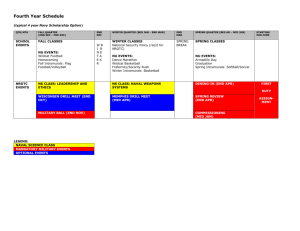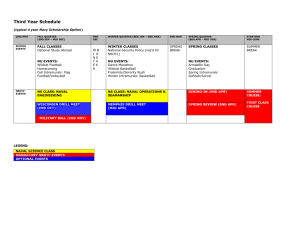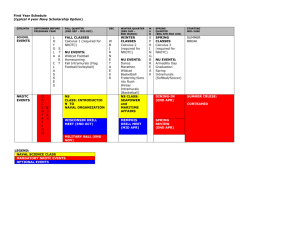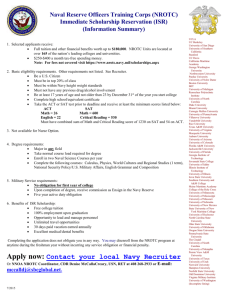Physical Fitness Requirements - University of Florida Navy ROTC
advertisement
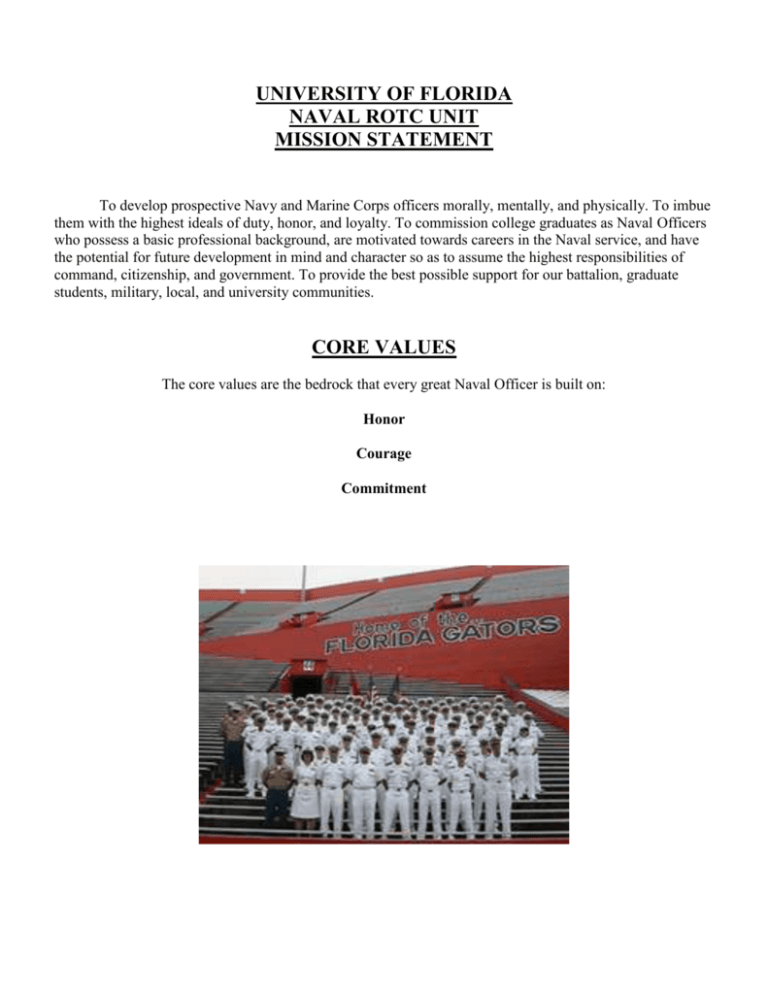
UNIVERSITY OF FLORIDA NAVAL ROTC UNIT MISSION STATEMENT To develop prospective Navy and Marine Corps officers morally, mentally, and physically. To imbue them with the highest ideals of duty, honor, and loyalty. To commission college graduates as Naval Officers who possess a basic professional background, are motivated towards careers in the Naval service, and have the potential for future development in mind and character so as to assume the highest responsibilities of command, citizenship, and government. To provide the best possible support for our battalion, graduate students, military, local, and university communities. CORE VALUES The core values are the bedrock that every great Naval Officer is built on: Honor Courage Commitment The UFNROTC Experience Orientation The first step for incoming fourth-class midshipmen is orientation. This weeklong program introduces new midshipmen to Navy life and prepares them for the challenges they will face as they are put in the unique position of simultaneously seeking a college degree and a commission in the United States Navy or Marine Corps. During orientation, midshipmen are instructed in ROTC policies, basic drill, uniform and grooming standards, and physical readiness. Midshipmen are introduced to the different career opportunities the Department of the Navy has to offer. Orientation includes tours of ships based in Mayport, Florida, aircraft squadrons at Naval Air Station Jacksonville, and submarines and a Marine security detachment at Kings Bay, Georgia. This exciting week is a great time to get to know your fellow midshipmen. The bonds formed at orientation often last all the way through a midshipman’s years at the University of Florida and beyond. Freshman Year The first year is always a great time at the University of Florida. While new midshipmen get familiar with classes and college life, they also get familiar with the Navy and Marine Corps team. Fourth-class midshipmen must first learn to lead by following. New midshipmen take classes in basic military knowledge and history. Along with the rest of the Battalion, they develop their knowledge of drill and develop their overall physical readiness through physical training sessions and a weekly afternoon drill period. The best naval officers are well-rounded individuals. New midshipmen are encouraged to get involved with the many opportunities that the University of Florida and the greater Gainesville community have to offer. A student can choose from a myriad of volunteer organizations, intramural sports, student groups and clubs, and fraternities and sororities to choose from. Participation in any of these groups can help to get the most out of a person’s time at the University of Florida. The Naval ROTC Battalion is a great resource during this time. Class advisors and fellow battalion members can help ensure that the transition to college life is going smoothly both academically and personally. CORTRAMID CORTRAMID stands for "Career Orientation and Training of Midshipmen". During this four-week period, scholarship midshipmen are introduced to many of the warfare communities within the Department of the Navy. Midshipmen spend a week on a surface ship, a week with an aviation squadron, a week on a submarine (female midshipmen included), and a week with the Marines. CORTRAMID is not only an opportunity to travel and get hands-on training; it is also a great opportunity to meet midshipmen from across the country. Whether it is flying in a T-34 aircraft or riding in the turret of an Amphibious Assault Vehicle, midshipmen often come back with great stories and the photos to prove them! Many (if not most) midshipmen consider CORTRAMID to be the most fun of all the summer cruises. Sophomore Year Midshipmen have now had an entire year to decide whether or not Naval ROTC and the Navy/Marine Corps team is right for them. Once a midshipman has sworn in at the beginning of sophomore year, leaving the program will mean repayment of scholarship money and/or enlistment in the Navy to recover the cost of training and educating the midshipman. It is during this year that midshipmen could take on increased leadership opportunities. Sophomore year is often the first chance a person has to obtain Gator home football tickets! Go Gators! Second-class Cruise All rising second-class Navy midshipmen on scholarship will go on a second-class cruise. The cruise, also known as an enlisted appreciation cruise, will acclimate midshipmen to the daily routine aboard a ship or submarine. Due to berthing constraints, female midshipmen may not select a submarine cruise. Midshipmen will spend a month with a ship or submarine. Often times these ships and subs are deployed and underway. University of Florida midshipmen have been seen port visits as far away as Scotland or Japan! During the cruise, the midshipmen will be assigned a "running mate"; the running mate is usually an experienced enlisted Sailor. The midshipman will essentially be a part of the crew and will gain an understanding of life as an enlisted Sailor. Junior Year During the junior year, a midshipman will be involved in the day-to-day operation of the Battalion. At the University of Florida, it is the midshipmen who are responsible for planning and carrying out events. Of course, Battalion members continue to learn unarmed drill and improve their physical readiness. It is also during this year that Marine Option midshipmen will prepare themselves for the rigors of Officer Candidate School. All those seeking a commission in the United States Marine Corps will attend OCS in Quantico, VA during the summer before their senior year. First-class Cruise While Marine Option midshipmen are busy at OCS in Quantico, Navy Option midshipmen are busy with a summer program of their own. All Navy Option midshipmen, regardless of scholarship status, must attend a first-class cruise. The first-class cruise serves to give Navy midshipmen insight into the life of a junior officer. Again, midshipmen are paired with a running mate, this time a junior officer. Midshipmen may complete their first class cruise aboard a ship, aboard a submarine, or with an aviation squadron (either ashore or afloat). Once again, midshipmen selecting ships or submarines often make port visits. Those selecting aviation cruises often come back with a few flights under their belts. A few other cruise opportunities exist, such as a foreign-exchange cruise or mini-BUD/S. Midshipmen interested in such cruises should contact their class advisors. Senior Year Senior year is an exciting time for ROTC midshipmen. Of course, seniors often hold leadership billets and determine the success of the ROTC unit. Furthermore, first-class midshipmen select which community they would like to join in the Navy. Service selections are sent out during the first semester and results are returned early in the second semester. Commissioning New Ensigns and Second Lieutenants from the Naval ROTC Battalion at the University of Florida are often surprised at how quickly the time has passed. It seemed like yesterday that they were being issued their uniforms for the first time and meeting new people at orientation. Commissioning is a new beginning. It is a time where new officers can take what they have learned and apply it to life in the fleet. New Ensigns and Second Lieutenants head off to their next duty station, bringing with them indomitable Gator spirit and the honor, courage, and commitment that they learned from the Naval ROTC Battalion of the University of Florida. UNIVERSITY OF FLORIDA NAVY ROTC UNIT CONTACT INFORMATION RANK/NAME POSITION EMAIL/PHONE CAPT ROBINSON, R. B. CO/PNS rrobinson@aa.ufl.edu (352)392-0973 CDR ZIEBARTH, K.W XO/APNS kziebarth@aa.ufl.edu (352)392-0973 MAJ WAIT, Dennis MOI marines@ufl.edu (352)294-0712 GySGT ROOKS, David AMOI drooks@aa.ufl.edu (352)294-0717 LT TOLSON, William Recruiting Officer tolsonb@ufl.edu (352)294-0713 TO CONTACT, DIAL (352)392-0973 A WEEK IN THE LIFE OF A MIDSHIPMEN Day Events Uniform MONDAY 0545-0700 1040-1130 1600- Marine/Remidial PT PT Gear NSC Class Appropriate Civilian Attire Study Hours (ACA) TUESDAY 1355-1550 Drill - NSC 1101 ACA / Uniform of the Day WEDNESDAY 0545-0700 1040-1130 1600- Battalion PT NSC Class Study Hours PT Gear ACA ACA THURSDAY 1355-1550 Muster for Battalion Drill NSC 1101 Uniform of the Day FRIDAY 0545-0700 1040-1130 1600- Marine/Remedial PT PT Geat NSC Class ACA Study Hours ACA Extra Requirements WATCH- As a midshipman you will be expected to stand regular watch at the NROTC Unit building Height And Weight Standards All NROTC midshipmen are expected to maintain optimum height/weight standards as follows. MAXIMUM WEIGHT BY HEIGHT AND GENDER HT 4-10 4-11 5-00 5-01 5-02 5-03 5-04 5-05 5-06 5-07 5-08 MALE FEMALE HT MALE FEMALE 5-09 5-10 5-11 6-00 6-01 6-02 6-03 186 191 196 201 206 211 216 174 177 181 141 150 155 160 165 170 175 181 131 136 141 145 149 152 156 160 163 167 170 Failing to meet the height and weight standards will require computation of body fat percentage. Navy Midshipmen must maintain a body fat percentage of 22% for males and 33% for females; Marine option Midshipmen must maintain a body fat percentage of 18% for males and 26% for females. However, a body fat percentage up to 4% greater than maximum is allowed for Marine options possessing a “First Class” PFT score. Percent body fat will be determined by the standards prescribed in OPNAVINST 6110.1G. Failure to meet these standards will result in counseling, and enrollment in remedial physical training. Physical Fitness Requirements A high level of physical fitness is absolutely necessary to succeed in the NROTC program. This requirement will remain essential as officers in the Navy and Marine Corps. Fitness level affects your service selection as well as class standing in the NROTC program. As an officer in the Navy or Marine Corps, you are a role model – being physically fit is expected. All Navy Midshipmen must score a “Good-Low” on the PRT, all marine option Midshipmen must score a 250 or better on the PFT, all failures will be counseled and enrolled in the remedial physical training program. PRT/ PFT FAILURES AND DEFICIENCIES FORMIDSHIPMEN, MECEPs AND STA-21 STUDENTS 1. A deficiency in a UFNROTC scored physical fitness standard will not be tolerated. Midshipmen, STA-21 and MECEP students are expected to maintain the physical fitness standards set forth in this instruction during their tenure at this unit. 2. Physical fitness standards are as follows: a. Midshipman (Navy Option)- Navy option midshipmen must maintain a Good/Low score on the PRT and be within Navy height/weight and body fat standards. b. Midshipman (Marine Option)- Male Marine option midshipman must maintain a PFT score of 250 with minimum run time of 22:00 min. and be within the USMC height/weight and body fat standards. Female Marine option midshipman must maintain a PFT score of 250 with minimum run time of 25:00 min. and be within the USMC height/weight and body fat standards. c. STA-21- STA-21 students must maintain a Good/Low score on the PRT and be within Navy’s height/weight and body fat standards. d. MECEP- Male MECEP students must maintain a PFT score of 250 with minimum run time of 22:00 min. and be within the USMC height/weight and body fat standards. Female MECEP students must maintain a PFT score of 250 with minimum run time of 25:00 min. and be within the USMC height/weight and body fat standards. 3. Failures are cumulative. Any scored failure will result in the next appropriate level of discipline. Failure to meet standards on a scored physical fitness event will result in the following disciplinary action: a. Midshipmen – First failure: Letter of warning, placement on remedial P.T. Second failure: Placement on probational leave of absence (LOA-resulting in loss of stipend), placement on remedial P.T., and letter to parents discussing potential loss of financial benefits and/or financial liability. Third failure: Placement on leave of absence, losing all scholarship benefits until successfully passing the PRT/PFT. Fourth failure: Dismissal from the NROTC program. b. STA-21- First failure: Letter of warning, placement on remedial P.T. Second failure: Placement on probation, aptitude score moved to the bottom of their class, placement on remedial P.T. Third failure: c. MECEP- Loss of scholarship and return to the fleet. (Note: Failure to maintain fleet standards of a satisfactory/marginal will be annotated on their next evaluation and accompany them back to the fleet.) First failure: Letter of warning, placement on remedial P.T. Second failure: Placement on probation, aptitude score moved to the bottom of their class, placement on remedial P.T. Third failure: Loss of scholarship and return to the fleet. (Note: Failure to maintain USMC 3rd class PFT will result in an adverse fitness report upon return to the fleet.) 4. Upon successfully passing a scored PRT/PFT following a period of LOA (full or probational), all financial benefits will be restored. However, the individual will remain in the remedial PRT/PFT program until two successive scored PRT/PFT events have been passed. 5. Remedial P.T. will begin on the first Monday following a failure of a scored event and will meet on Monday, Wednesday and Friday for two weeks. During this time remedial PT program students will learn the proper techniques of exercise and diet. After two weeks of remedial, students are expected to exercise individually in order to meet the NROTC physical fitness standards at the next scored event. 6. Prior to reporting to the UFNROTC unit, students will receive a welcome letter mail out. This package will include the UFNROTC physical fitness standards and direction to a website that describes the NETC physical fitness conditioning program. Each new student at the unit is responsible for applying the conditioning program in such a manner that they can meet the physical fitness standards during their tenure at UFNROTC. 7. Upon arrival at UFNROTC, new students will receive classes on training time out, the needs of self-reporting, acclimation/hydration and nutrition. The application of the content of these classes is the responsibility of each student. 8. No physical training will be conducted at the unit level until students have completed a DODMERB physical and, at the beginning of each term, a form SF93. In addition, a non-scored inventory PRT/ PFT will be conducted at the beginning of each term, along with a height/ weight and body fat measure, to afford students the opportunity for self-evaluation prior to a scored event. UNAUTHORIZED ABSENCE POLICY 1. Unauthorized absences (UA’s) will not be tolerated. During his/her tenure in the battalion, a midshipman will be subjected to the following disciplinary actions for UA’s: a. Every UA – The midshipman receives a formal counseling chit routed via the chain of command to his/her class advisor. b. Three total UA’s – Aptitude Warning and formal counseling by the Commandant of Midshipmen. c. Five total UA’s – Aptitude Probation including loss of stipend and formal counseling by the unit Executive Officer. d. Seven total UA’s – A performance review board leading to a Leave of Absence and formal counseling by the Professor of Naval Science. e. Eight total UA’s – Disenrollment from the NROTC program. NROTC Drug and Alcohol Policy Throughout its history, the Navy and Marine Corps have relied on certain core values for their success. Drug and alcohol abuse directly contradict these values. To prevent the occurrence of drug use, the Navy and Marine Corps have employed mandatory urinalysis screening for all personnel. Every member of the UFNROTC unit is subject to these random, mandatory tests. For cases in which a drug screening test returns with positive results, a “Performance Review Board” or PRB will be conducted. The PRB will normally recommend to the Commanding Officer that the student be disenrolled from the program. A student who has tested positive for drug use cannot enter active enlisted service and therefore repayment of scholarship funds is mandatory. Cases involving underage alcohol consumption will also result in a PRB. All Midshipmen, both scholarship and college program are required to meet the Navy’s policy concerning drug and alcohol use. All Midshipmen will have explained to them and will sign the Drug and Alcohol Abuse Statement of Understanding, prior to executing the enlistment contract and oath of office. Prior to induction in the Naval service, a statement indicating the Navy’s “zero tolerance” policy on drug use, the use of urinalysis procedures to detect drug use and the consequences should drug use be detected after commissioning will be acknowledged, in writing, by every Midshipman. NROTC Info Four Year Scholarship Full tuition at one of the listed college or universities All colleges/university educational fees Stipend for text books Provide all uniforms Subsistence allowance each academic month Class Current Stipends Freshman $250 Sophomore $300 Junior $350 Senior $400 Two Year Scholarship Covers final two years of college Provides tuition, fees, textbooks, and uniforms for two academic years Subsistence allowance for a maximum of 20 months Open to college students who have completed their sophomore year or third year in a five-year curriculum Deadline date: 15 March of the applicant's sophomore year On graduation commission as ensign, US Naval Reserve or second lieutenant, US Marine Corps Reserve Total military service obligation is eight years, at least four of which must be active duty NROTC College Program Two or Four year program Applicants selected from students already attending or accepted by colleges with NROTC programs Pays for uniforms and instructional fees for naval science courses College Program students selected for "advanced standing" receive a stipend for maximum of 20 months. Advance standing is only available starting the junior year of college. Stipend per academic month is $350 junior year and $400 senior year. Students will complete naval science and other university courses, a few specific university courses, and attend one summer training session. Normally at sea for Navy officers Normally at Quantico, VA for Marine Corps-option midshipmen Four-year applicants apply through professors of naval science upon commencement of freshman year Two-year applicants apply before spring of sophomore year When accepted, two-year applicants will attend six-and-a-half week Naval Science Institute program in Newport, RI during summer between sophomore and junior years On graduation, two- and four-year College Program midshipmen may be commissioned ensigns in the Naval Reserve or second lieutenants in the Marine Corps Reserves Obligation of eight years commissioned service, at least three of which must be active duty Navy Nurse Corps NROTC Program Available to students interested in pursuing bachelor of science degree in nursing (BSN) If selected for scholarship, selectee must major in a nursing degree program leading to BSN On graduation, Nurse NROTC Scholarship Program midshipmen commissioned as reserve officers in Navy Nurse Corps Nurse NROTC eligibility and selection procedures same as regular four-year NROTC Scholarship Program requirements Academic, physical, and military requirements differ slightly from regular NROTC Nurse NROTC Scholarship Program not for those pursuing any other medical program. Unit Courses NSC 1101 - Naval Science Laboratory: 0 credit hours Drill, basic commands, courtesies and honors; orientation and information period. NSC 1110 - Introduction to Naval Science: 2 credit hours A general introduction to the naval profession and to concepts of seapower. Instruction emphasizes the mission, organization, and warfare components of the Navy and Marine Corps. Included is an overview of officer and enlisted ranks and rates, training and education, and career patterns. The course also covers naval courtesy and customs, military justice, leadership and nomenclature. This course exposes the student to the professional competencies required to become a naval officer. NSC 1140 - Seapower and Maritime Affairs: 3 credit hours A survey of U.S. naval history from the Phoenicians to the present, with emphasis on major developments. Included is an in-depth discussion of the geopolitical theory of Mahan. The course also treats present day concerns in seapower and maritime affairs, including the economic and political issues of merchant marine commerce, the Navy’s involvement in liberation and terrorist movements overseas, and the massive changes in the U.S. Navy due to the break up of the Soviet Union. NSC 2102 - Naval Science Laboratory: 0 credit hours Drill, basic commands, courtesies and honors; orientation and information period. NSC 2121 - Naval Ships Systems 1 (Engineering): 3 credit hours The objectives of the course are to learn basic power systems used in naval propulsion systems, a basic understanding of the thermodynamic process, a working knowledge of major auxiliary ship systems, basic consideration for ship design and stability. Basic electrical theory and damage control are included. NSC 2122 - Naval Ships Systems 2 (Weapons): 3 credit hours This course provides an introduction to the theory, characteristics, and principles of operation of naval weapons systems. It includes coverage of types of weapons and fire control systems, capabilities and limitations, theory of target acquisition, identification and tracking, trajectory principles, and basics of naval ordnance. NSC 3103L - Naval Science Laboratory: 0 credit hours Practical exercises dealing with the specifics of naval organizations and leadership. NSC 3214C - Navigation and Naval Operations 1: 3 credit hours A comprehensive study of the theory, principles, and procedures of ship navigation and movements. Topics include piloting and dead reckoning as well as principles of celestial and electronic navigation, an in-depth exposure to the navigational "rules-of-the-road," and the International Regulations for Preventing Collisions at Sea and their application to effective safe navigation. Practical lab work in charting, publication usage. NSC 3215C - Navigation & Naval Operations 2: 3 credit hours A continuation of NSC3214C. Topics include relative motion theory and the use of a maneuvering board, an understanding of the force, techniques and concepts associated with ship handling is developed as well as exposure to shipboard watch organization, communication systems and environmental considerations. The role of leadership ethics will be discussed while developing an understanding of the process of command and control, dealing specifically with information exchange, conflict resolution, and crisis decision making. NSC 3221 - Evolution of Warfare: 3 credit hours The purpose of this course is to explore the form of warfare employed by great people in history in order to formulate the sense of historical flow or continuity in the evolution of warfare, to develop a basic sense of strategy, to demonstrate alternative military actions and to explore the impact of historical precedent on military thought and actions as practiced by the great leaders and military organizations. NSC 4104L - Naval Science Laboratory: 0 credit hours Practical exercises dealing with the specifics of naval organizations and leadership. NSC 4224 - Amphibious Warfare: 3 credit hours A historical survey of the projection of sea power ashore. The course seeks to define the concept, explore its doctrinal origins, and trace its evolution as an element of naval policy during the twentieth century. The case study method is used alongside the theme of general historical continuity to develop an understanding of the relatively new and still maturing concept of amphibious warfare. NSC 4230 - Leadership and Management: 2 credit hours An introduction to the principles of naval administration, stressing the experimental approach to learning the principles of leadership and management. The student develops skills in the areas of communication, counseling, control, direction, leadership and management functions and responsibilities through active guided participation in naval-based case studies, experimental exercises and situational problems. Total quality leadership and professional responsibilities are included. NSC 4233 - Junior Naval Officer: 3 credit hours A course designed to equip the NROTC student with the skills and abilities required for competence as a commissioned officer. Naval personnel and material management, the administration of division discipline and human resource management are the major areas of focus for this course. This final capstone course in the NROTC curriculum builds upon and focuses the managerial, professional and ethical competencies developed during prior summer cruise training and naval science courses. NSC 4905C - Independent Study: 1-3 credit hours Readings, assignments, student presentations and discussions on various topics of naval science. University of Florida NROTC Course Requirements Naval Science Courses Navy NSC1110 NSC1140 NSC2121 NSC2122 NSC3214 NSC3215 NSC4230 NSC4233 College Courses Navy Scholarship Students Required by the end of sophomore year: Calculus 1 (MAC2311 or equivalent) Calculus 2 (MAC2312 or equivalent) Required by the end of sophomore year: Physics 1 (PHY 2048 or equivalent) Physics 1 (PHY 2048 or equivalent) Required prior to graduation: National Security Policy / International Relations (INR2001), or American Military History (AMH4546) English (6 credits) Navy College Program Students Required by the end of the Junior year: College Algebra or higher level mathematics (6 credits) Required by the end of the senior year: Physical Science including appropriate laboratory classes (6 credits) Required prior to graduation: Computer Science (3 credits) English (6 credits) MARINE 1110 1140 3221 4244 4230 4233 NURSE 1110 1140 4230 4233 MECEP 3221 4244 Required prior to graduation except MECEP: National Security Policy (INR 2001) American Military History (AMH 4526) or other relevant courses approved by the PNS ALL Nurse Option Required prior to graduation: English (6 credits)
